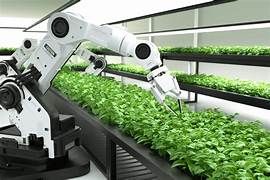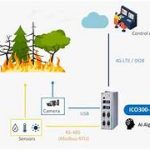AI Applications in Sustainable Agriculture: A Comprehensive Guide
Sustainable agriculture is an essential approach to farming that seeks to meet the growing demand for food while maintaining environmental health, conserving natural resources, and promoting social equity. In recent years, Artificial Intelligence (AI) has emerged as a transformative technology that is helping to revolutionize agriculture. AI applications in sustainable farming are contributing to increased efficiency, reduced environmental impact, and better decision-making for farmers. This article explores the various AI-driven innovations shaping the future of sustainable agriculture.
1. Precision Agriculture: Optimizing Resource Use
One of the key areas where AI is making a significant impact in sustainable agriculture is in precision farming. Precision agriculture refers to the use of data and technology to optimize farming practices, ensuring that resources such as water, nutrients, and energy are used efficiently and sustainably. AI technologies, such as machine learning (ML) algorithms, help farmers monitor and manage crop health, soil conditions, and weather patterns in real time.
AI-driven tools like drones and sensors collect vast amounts of data from the field, which is then analyzed to identify areas that require attention. For example, AI can determine the exact amount of water, fertilizer, or pesticide required for each part of a field, thereby reducing waste and minimizing environmental impact. By applying resources only where and when they are needed, AI-enabled precision agriculture reduces overuse and minimizes harm to the ecosystem, supporting sustainable farming practices.
2. AI for Crop Monitoring and Disease Management
Another significant AI application is in crop monitoring and disease management. Farmers can use AI-powered image recognition and computer vision systems to detect early signs of diseases, pests, and nutrient deficiencies. AI systems can analyze images from satellites, drones, or ground-level cameras to identify patterns and anomalies that humans might miss.
AI models can detect changes in plant health by analyzing variables like color, texture, and shape. For instance, machine learning algorithms can analyze leaf patterns to detect early-stage disease outbreaks or nutritional imbalances. This early detection allows farmers to take timely action, preventing the spread of diseases and reducing the need for harmful chemicals, which helps reduce pesticide usage and supports more sustainable farming practices.
3. Autonomous Machinery for Sustainable Farming
Autonomous machinery is another AI-driven innovation transforming agriculture. From autonomous tractors to robotic harvesters, AI-powered machines are improving efficiency in the field while minimizing the carbon footprint of agricultural operations. These machines are capable of performing tasks such as planting, irrigation, fertilization, and harvesting with minimal human intervention.
For example, autonomous tractors equipped with AI algorithms can perform precision tilling, reducing soil compaction and erosion, which are key factors in sustainable farming. Similarly, AI-powered robotic harvesters use advanced sensors to pick crops with precision, reducing waste and damage to the plants. By automating labor-intensive tasks, AI technologies help farmers reduce their reliance on manual labor, minimize fuel consumption, and increase productivity, all of which contribute to more sustainable agricultural practices.
4. AI in Irrigation Management
Water scarcity is one of the most pressing challenges facing agriculture today. Efficient water use is critical for sustainable farming, and AI technologies are playing a key role in improving irrigation management. AI-driven systems, including smart sensors and weather forecasting tools, can provide farmers with real-time data on soil moisture, weather conditions, and crop water requirements.
AI can predict weather patterns and monitor soil moisture levels, enabling farmers to optimize irrigation schedules and water usage. By ensuring that crops receive the right amount of water at the right time, AI reduces water waste and helps conserve this valuable resource. In addition, AI can detect inefficiencies in irrigation systems, identifying areas where water may be overused or lost due to leaks or malfunctioning equipment.
5. AI-Driven Supply Chain Optimization
Sustainable agriculture is not just about improving farming practices but also about ensuring that the entire food production and distribution system is efficient and eco-friendly. AI has the potential to optimize agricultural supply chains by improving demand forecasting, reducing food waste, and enhancing logistics.
AI systems can predict consumer demand for specific crops, helping farmers plan production more accurately. Additionally, AI can optimize transportation routes and storage conditions, reducing energy consumption and spoilage. By enhancing supply chain efficiency, AI contributes to reducing the environmental footprint of food production and distribution, further supporting the goals of sustainable agriculture.
6. Data-Driven Decision Making for Farm Management
Data is at the heart of AI applications in agriculture. Farmers have access to a wealth of data from various sources, including satellite imagery, soil sensors, weather stations, and crop performance metrics. AI technologies, such as machine learning algorithms and predictive analytics, enable farmers to analyze this data and make informed decisions about planting, irrigation, fertilization, pest control, and harvest timing.
AI-powered decision support systems provide farmers with insights into the best practices for improving yields while minimizing environmental impact. These systems take into account multiple variables, such as soil type, crop variety, and climate conditions, to recommend personalized farming strategies. By leveraging AI, farmers can adopt a more data-driven approach to farming, which enhances productivity and sustainability.
7. AI for Soil Health and Fertility Management
Maintaining healthy soils is essential for sustainable agriculture. AI technologies are increasingly being used to monitor and improve soil health, which is critical for ensuring long-term productivity and ecological balance. AI systems analyze soil composition, nutrient levels, and other factors to provide farmers with detailed insights into the health of their soil.
AI models can predict soil fertility and recommend appropriate interventions, such as adding specific nutrients or organic matter. By using AI to monitor soil health, farmers can avoid over-fertilizing, which can lead to nutrient runoff and environmental pollution. This helps maintain the balance of nutrients in the soil and supports sustainable crop production.
8. Reducing Food Waste with AI
Food waste is a significant challenge for the global food system, with up to one-third of food produced being lost or wasted each year. AI has the potential to address this issue by optimizing harvest times, improving storage conditions, and enhancing food sorting and distribution processes. AI systems can monitor crops to determine the optimal time for harvest, ensuring that produce is picked at its peak and reducing the likelihood of spoilage.
AI-powered sorting systems can also be used to categorize and grade produce based on quality, allowing lower-grade items to be diverted to alternative markets, such as processing or animal feed, rather than being discarded. By improving the efficiency of the food system, AI helps reduce waste and promote sustainability throughout the agricultural supply chain.
9. AI in Sustainable Livestock Farming
Sustainable livestock farming is another area where AI is making a significant impact. AI-driven technologies are being used to monitor the health and welfare of animals, optimize feeding schedules, and improve breeding practices. For instance, AI-powered sensors and cameras can track animal behavior, detect early signs of illness, and monitor the quality of feed.
By using AI to monitor livestock health, farmers can reduce the need for antibiotics and other treatments, ensuring more sustainable and humane farming practices. AI also supports the optimization of feed efficiency, helping reduce feed waste and the environmental impact of livestock farming.
10. AI and Climate-Smart Agriculture
Climate change poses significant challenges to agriculture, with unpredictable weather patterns, shifting growing seasons, and increased risk of pests and diseases. AI is helping farmers adapt to these changes by providing real-time weather data, predictive models, and climate-smart farming practices. By analyzing historical climate data and current conditions, AI can help farmers make informed decisions about crop selection, planting schedules, and pest management.
In addition, AI-powered tools can help farmers identify areas of vulnerability within their operations, allowing them to implement climate-resilient strategies. By incorporating AI into their farming practices, farmers can enhance their resilience to climate change while promoting sustainable agriculture.
Conclusion
AI is transforming the landscape of sustainable agriculture by providing innovative solutions to long-standing challenges. From precision farming to AI-driven crop monitoring, autonomous machinery, and climate-smart agriculture, AI applications are helping farmers reduce environmental impact, optimize resource use, and improve productivity. As the global population continues to grow, the integration of AI into agricultural practices will be essential in ensuring food security while promoting sustainability. By leveraging the power of AI, farmers can adopt more efficient, eco-friendly practices that contribute to a healthier planet and a more sustainable food system.


